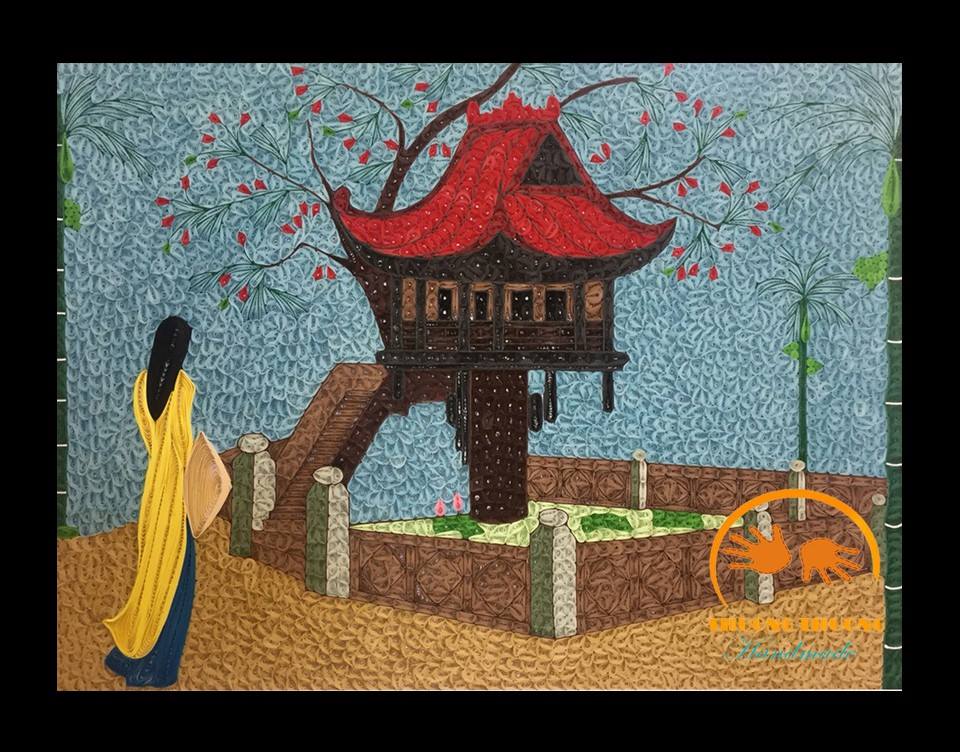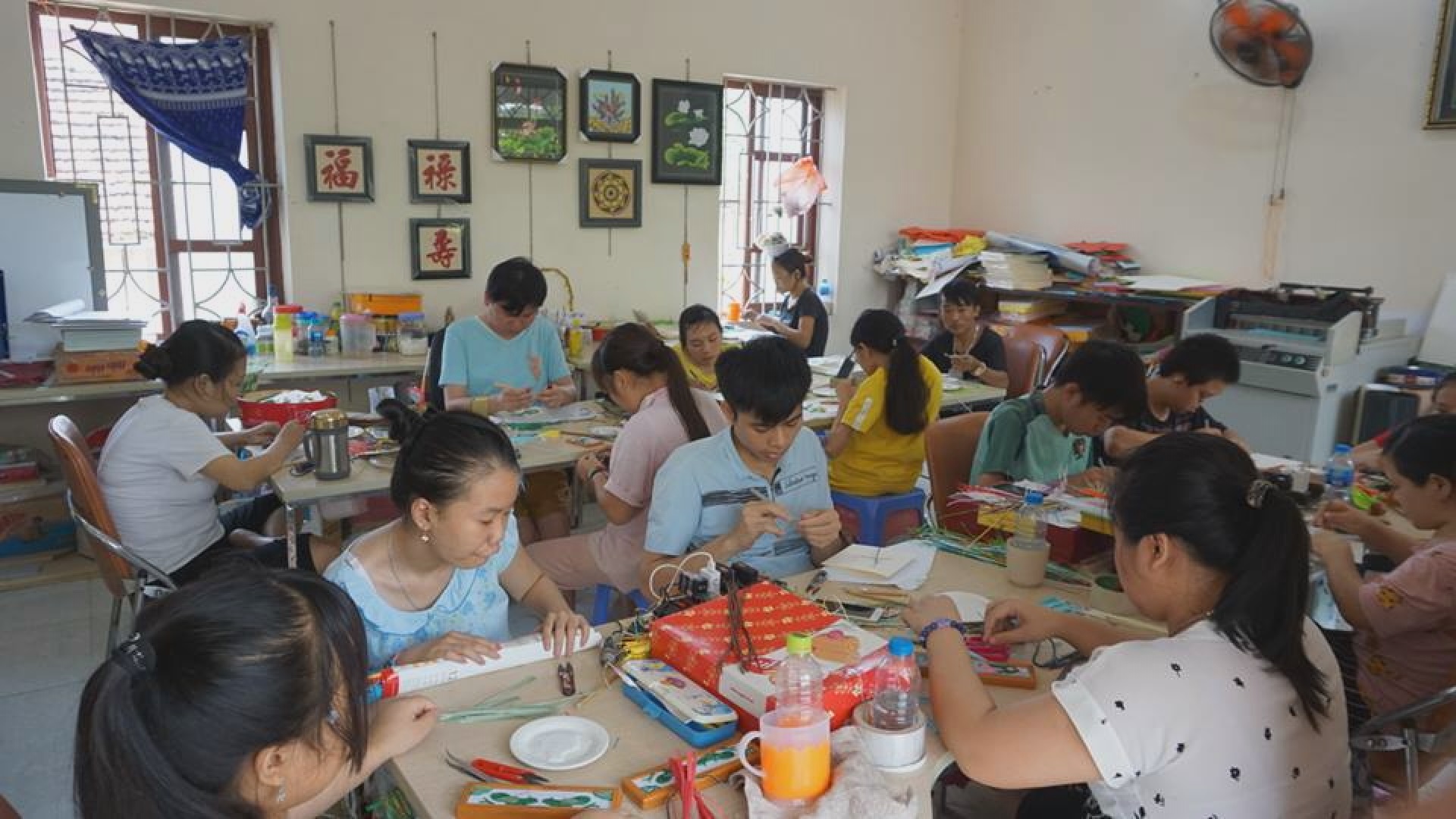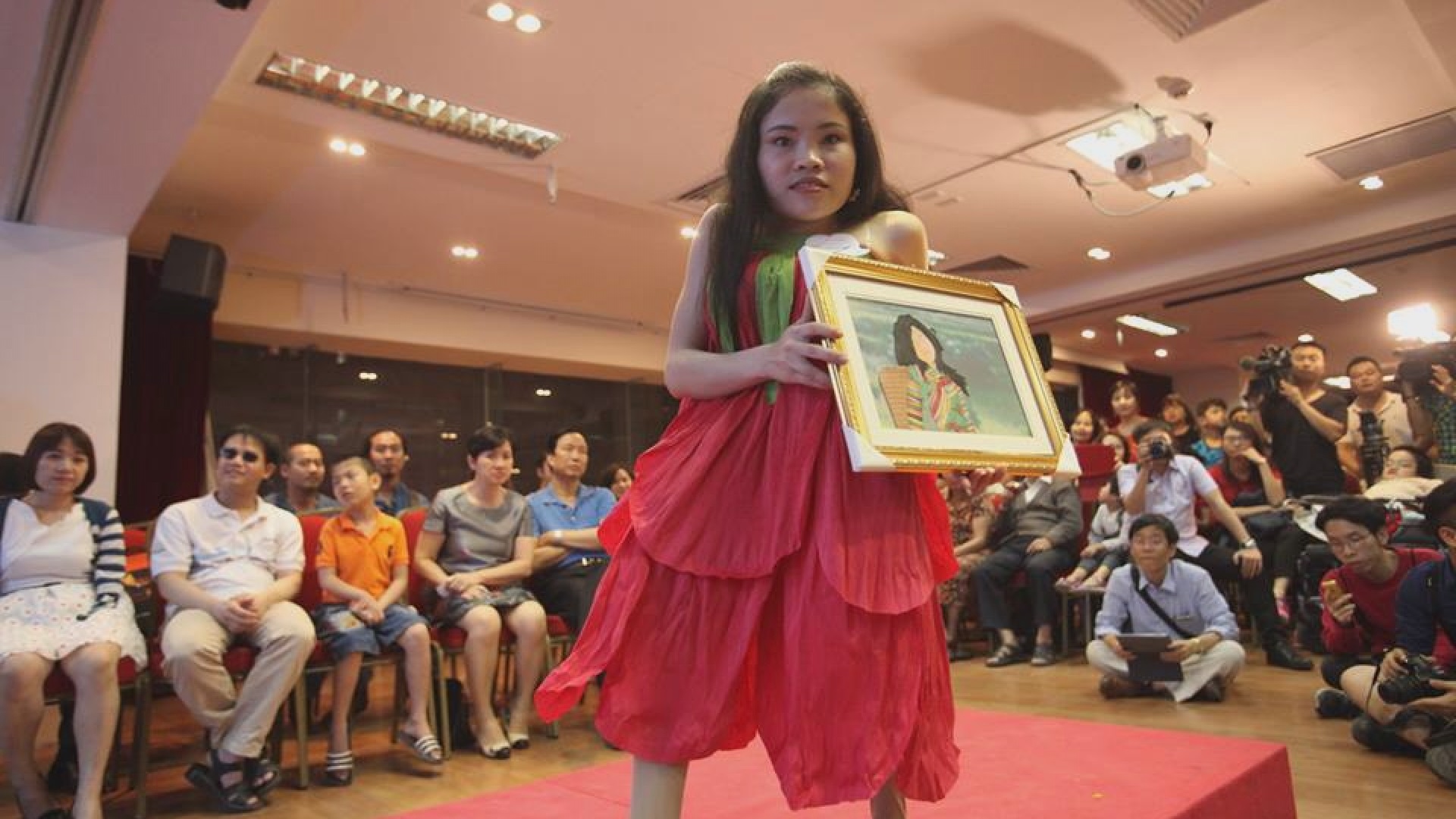The woman is Nguyen Thi Thu Thuong, who is Director of the Thuong Thuong Handmade Company, producing paper quilling crafts with over 20 full-time staff, all of whom live with various kinds of disabilities. Together, they live and work at her family home in the outskirts of Hanoi.
Thuong, 36, lives with constant physical pain and daily inconveniences caused by her brittle bone disease. However, she fills her spare times with finding ways to not only help herself literally and mentally stand up, but also in assisting others in the disabled community.
Bone breakage a common occurrence
Nguyen Thi Thu Thuong was born with brittle bone disease (osteogenesis imperfecta), which prevents her from doing a lot of activities that most able-bodied people take for granted, including walking, standing, sitting, or even clapping her hands. Her movement is restricted to minimal body shifting and she is wheelchair-dependent.
However, Thuong has managed to support herself with her daily needs as much as possible, not wanting to be fully dependent on or become a burden for her family members due to her condition. She eats, talks on the phone, and works with a laptop lying on her bed.
“You may feel sorry for me, seeing me lying down and eating, but I am fine with that,” Thuong told the Vietnam News Agency reporter as she finished her noodle breakfast before the interview.
As part of the consequences of the disease, her bones are highly prone to breakage if she exerts or moves herself too much. However, sometimes they can simple break without any catalyst or movement.
“My bones break before I even know it. I feel like I am sat on fire constantly because the pain can come at any time,” said Thuong.
The fact that Thuong has worked so hard to achieve this level of independence is certainly a matter of pride for her, as when she faces another bone-breakage incident, it is a struggle to stay positive. What’s more, these incidents are fairly common, sometimes not occurring for months, other times it is only a matter of weeks or days before the next fracture.
From self-care to sheltering others
Thuong is only 80cm tall and weighs 20 kg with short, fragile limbs. All her life, Thuong has tried to come to terms with the physical pain and inconveniences caused by her condition, while also striving to find a suitable livelihood so she does not have to rely on others financially.
She has been through numerous jobs, including knitting and making bags. During the process, she witnessed many other people with disabilities struggling as hard as herself to earn an income.
Eventually, a friend taught her the art of quilling, a craft that involves the coiling and shaping of narrow, multicolour paper strips to create intriguing shapes and designs, often used for handmade cards, earrings, and paintings, among others.
Thuong found quilling to be a craft that is more accessible for people with disabilities, while also a more profitable endeavour, sellable as handmade art.

Quilling artworks made by disabled artists (Photo: VNA)
“Quilling is fun, creative and easy to do with a fair amount of patience, which I am sure is doable for people with disabilities. Our workers just use strips of lightweight paper, glue, and a tool with which to roll the paper – that’s it!” Thuong said.
Thuong’s vision grew when she decided to go beyond her own livelihood and create jobs for other people with disabilities. Needless to say, she faced far more obstacles than able-bodied entrepreneurs wanting to open a startup, so much so that she often wanted to give up and quit.
However, Thuong kept on fighting with all available resources.
“I hate being alone and like being around people. That’s what pushes me to move forward, either this or that way,” Thuong said.
After 10 years of nursing her dream, in 2014 she established the Thuong Thuong Vocational Training Centre at her family’s house in Nam Phu village, Nam Phong commune, in Hanoi’s Phu Xuyen district.
Following the launch, Thuong provided free quilling training and accommodation for a dozen people at the centre. The trainees were even paid for their products, around 2 million VND (100 USD), depending on their level of productivity.

There are over 20 staff working at Thuong Thuong Handmade workshop (Photo: VNA)
Hoang Phuong Thao, 24, is one of the 20 staff members at the centre, all of whom have some form of disability and come from across the nation, including Tuyen Quang, Ha Giang, Bac Giang, Son La, Hoa Binh, and Nam Dinh.
Thao, from Tuyen Quang, has worked and lived at the centre for over three years. She considers it her second family and feels confident with this community, which also provides her with a stable-income job.
“Now, I don’t feel like a misfit like I used to. We are like a family here,” Thao said, recalling her past struggles when she viewed herself a burden for he family.
Thao expressed her admiration for Director Thuong, saying her boss sets a good example for the staff in particular, and persons with disabilities in general, to follow and make the most out of their lives.
For her tireless efforts and inspirational actions, Thuong has been honoured with numerous awards and certificates by local authorities, including the Women Vision Award by the Hanoi International Women Club in 2015.

Thuong was honoured with the Women Vision Award in 2015 (Photo: Courtesy of Thuong)
Dedication to the path of success
Brittle bone disease never stops Nguyen Thi Thu Thuong from finding ways to reach out to more disadvantaged people. She started researching and learning how to use more technology, taking advantage of online sales software and marketing skills.
In 2015, she established the Dong Da district-based Thuong Thuong Handmade JSC and ran a website and Facebook account of the same name to better promote her products, while seeking potential clients, locally and overseas, to expand her business.
“So far, we have received large and regular purchase orders from local authorities, companies and universities, who buy our artworks and use them as souvenirs,” Thuong said, adding that some request for their logos to be crafted on the products.
Thuong Thuong Handmade also hosted events to promote her products and the quilling art, while creating opportunities for her staff to integrate better into the community.
“I want to make sure that my staff stay positive and clients buy our products for their worth, not for their sympathy for the disabled artists,” Thuong said.

Thuong Thuong Handmade hosted a fashion show in Hanoi, featuring her staff as models. Hoang Phuong Thao wears a paper dress and a quilling artwork she has made (Photo: Courtesy of Thuong)
This year, she applied and received financial assistance from the US’ Thriive Charity Fund to equip her facility with more paper cutters and other quilling supplies, thus recruiting more disadvantaged workers.
Pham Vu Thang, Director of the Hanoi Thriive Fund, which bases in the VNU University of Economics and Business (UEB), said knowing the charitable work Thuong is doing, the fund officials visited Thuong’s facility, provided her machineries, and business management skills, so she can expand her business and help more disadvantaged people.
“We just ordered the company to make boxes of name cards with the UEB’s logo,” said Thang, who is also a teacher at the UEB.
The university also buys Thuong Thuong crafts and give them as souvenirs to its teachers on festival occasions and its international guests, Thang said, hoping other educational institutions will do the same, thus helping Thuong increase her sales.
As for Director Thuong, she is happy because her efforts have been rewarded. More clients, both local and overseas are showing interests in her products. The centre’s staff number has also been increasing, along with the variety of its products and staff incomes, up to over 6 million VND (nearly 300 USD) per month, each.
Positive outlook, high self-esteem
Despite social stigmas surrounding her physical condition, Thuong has a healthy level of self-esteem, viewing her disability as only one singular component that makes up her life, going by the motto: “You can only be accepted by others once you are able to accept yourself as you are.”
“When I look at you, I think I am as beautiful as you are,” Thuong told the Vietnam News Agency reporter, laughing joyously and putting on lotus lipstick to make her more beautiful before going Facebook streamlive on how she was in the shooting for Vnews Channel.
However, Thuong herself is not always smiling and strong. Sometimes, she ironically wishes that she had other kinds of physical disabilities that were less challenging.
“We all have high and low moments. Whenever I am down, I take a good sleep or eat something and I will feel fresh and healthy the next morning,” advises Thuong on how she overcomes low moments.
Thuong believes her mother, who has supported her more than anyone else, is the one who helps her here.
Thuong always brings her motto to the public talks that she has been invited to, telling both able-bodied and disabled persons her life story.
“From what I have been through, I want to offer a message to parents of disabled children: Please listen to your children. Encourage them to do what they can.”
“And those with disabilities: Never envision a bad future for yourself. View your worth as a person first. A disability is only one facet of a person.”
Thuong never sees herself as being disabled as otherwise, she would fail herself.
Osteogenesis imperfecta (OI), also known as brittle bone disease, is a group of genetic disorders that mainly affect bones. The disease causes fragile bones which are often prone to frequent breaking. According to Dr. Vu Chi Dung, Head of the Medical Genetics, Metabolism and Endocrinology under the Vietnam National Children’s Hospital, OI affects about one in 15,000 people. There is no official statistics on OI cases in Vietnam as of yet. Unfortunately, there is no cure. Treatment may include care of broken bones, pain medication, physical therapy, braces or wheelchairs and surgery. The treatment is very expensive and needs to be taken for long periods of time and as such, most of the affected patients and their families are unable to afford it. Since 2004, the hospital has used bisphosphonate pamidronate reduce fractures in patients with OI. All Vietnamese persons with disabilities have been covered with health insurance. However, bisphosphonate pamidronate is yet to be covered by health insurance costs. The hospital is seeking the Health Ministry’s approval for the medication to be covered by health insurance to reduce financial burden for its patients. |

 Print page
Print page Back page
Back page